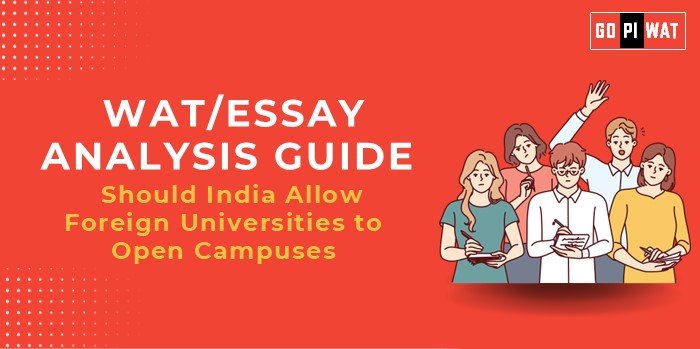📋 WAT/Essay Analysis Guide: Should India Allow Foreign Universities to Open Campuses?
🌐 Understanding the Topic’s Importance
📚 Significance: This essay intersects global education trends, economic policies, and the National Education Policy 2020’s vision, making it critical for B-school applicants to analyze.
📝 Effective Planning and Writing
- ⏳ Time Allocation:
- 🕒 Planning: 5 minutes
- 🖊️ Writing: 20 minutes
- 🔍 Review: 5 minutes
- 📋 Preparation Tips:
- 📊 Note statistics (e.g., India spends $28 billion annually on outbound students).
- 🌍 Focus on global comparisons and case studies (e.g., China, Singapore).
💡 Introduction Techniques for Essays
- ⚖️ Contrast Approach: “While millions of Indian students study abroad annually, India’s own universities struggle to attract foreign talent. Could allowing global universities address this imbalance?”
- 🔑 Solution-Based Approach: “Inviting foreign universities could be India’s solution to bridging skill gaps and reducing economic losses caused by outbound education spending.”
🛠️ Structuring the Essay Body
- 🏆 Achievements:
- 📈 Global Teaching Standards: Reduced brain drain and enhanced research opportunities.
- 🌏 Case Example: China’s successful partnerships with Duke and NYU.
- ⚠️ Challenges:
- 📉 Risk of Inequality: Increased tuition fees and limited access for underprivileged groups.
- 🚧 Regulatory Challenges: Ambiguities in laws and local opposition.
- 🌟 Future Outlook:
- 📚 Policies for Affordability: Fee caps and scholarships to ensure inclusivity.
- 🌍 Regional Education Hub: Potential to attract students from South Asia.
📊 Analyzing Successes and Shortcomings
🎯 Key Successes
- 📚 Improved Quality of Higher Education: Advanced teaching methodologies and research capabilities introduced by foreign universities.
- 💸 Reduced Economic Outflow: Retention of a share of the $28 billion Indians spend annually on overseas education.
- 🌐 Global Exposure: Accessibility to international-standard education locally.
- 🔬 Research Boost: Increased global research funding and expertise.
⚠️ Ongoing Challenges
- 💰 Risk of Commercialization: High tuition fees limiting access to lower-income groups.
- 🏫 Impact on Local Universities: Potential marginalization of domestic institutions due to competition.
- 📜 Regulatory Hurdles: Slow approval processes and accreditation ambiguities.
🌍 Global Context
- 🇨🇳 China: Partnerships with Duke and NYU enhanced global rankings and research opportunities.
- 🇸🇬 Singapore: Flexible policies attracted MIT and INSEAD, making it an ASEAN education hub.
- 🇰🇷 South Korea: Challenges with limited student interest and regulatory constraints.
🌟 Implications for India
- ⚖️ Balancing Equity: Implementing fee caps or scholarships to ensure access for underprivileged groups.
- 🤝 Strengthening Domestic Universities: Encouraging collaboration between local and foreign institutions.
- 📜 Effective Regulation: Streamlined policies and transparent operational guidelines to avoid delays.
📄 Concluding Effectively
- ⚖️ Balanced Conclusion: “Foreign universities can complement India’s education system if regulatory frameworks prioritize affordability, inclusivity, and collaboration with local institutions.”
- 🌍 Global Comparison Conclusion: “Learning from countries like China and Singapore, India can leverage foreign universities to enhance its global education footprint while safeguarding equity.”
📚 Sample Short Essays (100 Words Each)
- 📋 Balanced Perspective: “While foreign universities offer immense opportunities for India’s higher education, strict regulatory mechanisms are essential to ensure equitable access.”
- 🔍 Solution-Oriented: “Collaborations between foreign and Indian universities can combine global excellence with local relevance, fostering a world-class education ecosystem.”
- 🌏 Global Comparison: “India’s NEP 2020 could replicate Singapore’s model by incentivizing foreign campuses, ensuring a balance of quality and inclusivity.”


